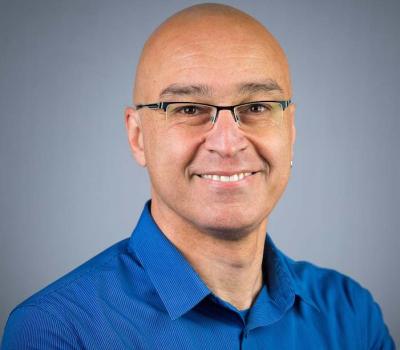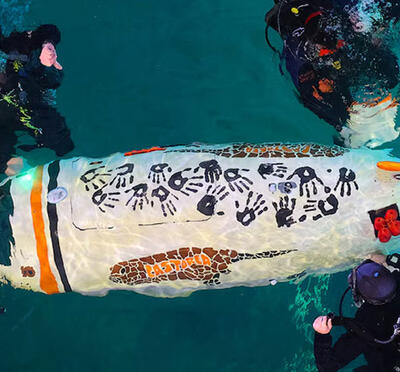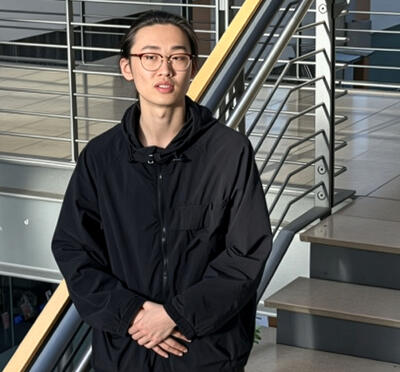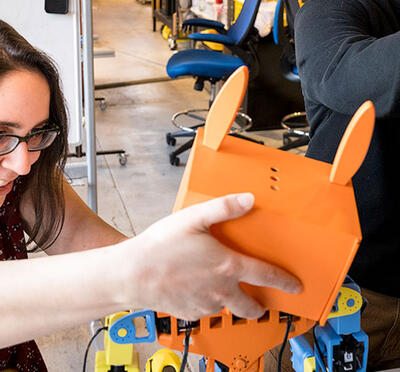Since 1920, Graf Hall — originally Engineering Hall — has endured as a stalwart of the College of Engineering. Over the decades, its cavernous high bay has housed materials labs, hydraulics labs, and steam and gas engine labs, all served by a 5-ton overhead crane. Using a monstrous, two-story machine nicknamed “the Nutcracker,” researchers brutally tested the strength of construction materials. Offices and smaller labs have occupied Graf’s west end and ground floor, and a radio tower once soared above the roof.
The building was renamed in 1967 to honor the memory of Samuel H. Graf, a faculty member of 45 years who earned five engineering degrees and left an indelible mark on the college. But nearly a century of constant use had taken its toll. By the early 2000s, the venerable building looked tired, and the high bay had devolved into a jumble of research stations and storage.
“Graf had become a dreary place,” said Belinda Batten, executive associate dean of the College of Engineering. “Things just got stuck there.”
That all changed in 2015, when the college’s burgeoning robotics program consolidated its dispersed labs and faculty in Graf.
“People couldn’t believe we’d want to move there; it was in rough shape,” said Kagan Tumer, professor of mechanical engineering and director of the Collaborative Robotics and Intelligent Systems Institute. “But the wide-open high bay is exactly what we needed to accommodate our growth and promote the interchange of ideas. Without physical barriers between labs, researchers from different disciplines are more likely to get to know one another. You never know who will help you solve a big problem.”
In preparation for the robotics move-in, Graf underwent a $1 million renovation. The dingy high bay was transformed into a stunning research space. New offices and conference rooms went up on the third floor to serve the quickly expanding faculty ranks. The college continues to seek funds to complete the transformation of Graf Hall into a world-class robotics hub.
“The building still has a kind of warehouse feel, but that’s OK, because it’s become this vibrant place of energy and ideas. Many of our students and faculty could have gone anywhere to do their robotics work, but they chose to come to Oregon State because of our people and our resources, and Graf Hall has become an important part of that mix,” Batten said.
The updated robotics lab had a major impact on Joe Davidson’s decision to join the faculty.
“Labs at other institutions I visited were very compartmentalized, but at Graf, you can’t help but engage with colleagues from different disciplines. You’re just a few steps away,” said Davidson, an assistant professor of robotics, who arrived in September 2018. “People share and combine resources, which promotes collaboration unlike any place I’ve seen.”
The power of that free flow of ideas played out on a Tuesday night last October, when Julie A. Adams, professor of computer science, was in California preparing a Department of Defense-funded robot deployment for the following morning. When Adams encountered coding trouble, she emailed several graduate students from various robotics labs, including doctoral student Seth McCammon from the Robotic Decision Making Laboratory. After some email exchanges, he and a colleague from a different robotics lab met in a Graf conference room to work the problem.
“I had to go grab something from my lab, and I happened to run into another grad student that I knew who was working late,” McCammon said. “I asked him if he was familiar with this obscure coding bug we were dealing with, and he said he was.”
Together — well after midnight — they cobbled together a last-minute patch, which was enough to complete the deployment, according to McCammon.
“Even though we worked in different areas, we knew each other because we run into each other in Graf,” he said. “If our labs were siloed and separated by walls, I doubt I would have known the right people to solve the problem.”




